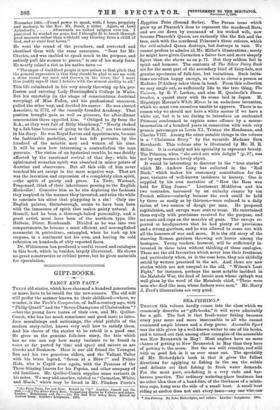GIFT-BOOKS.
FANCY AND FACT.*
THESE old stories, which have charmed a hundred generations or more, have to be retold for the new-comers. The old will still prefer the manner known to their childhood—where, we wonder, is the Youth's Companion, of half-a-century ago, with "Philip Quarll" and the " Seven Champions of Christendom" —but the young have tastes of their own, and Mr. Quiller- Conch, who has too much conscience and good taste to intro- duce moralisings and satirisings, the chief pitfalls of the modern story-teller, knows very well how to satisfy them. And his choice of the stories to be retold is a good one. He gives us the genuine folk-lore story, the tale which has no one can say how many variants to be found in races so far parted by time and space and nature as are Greeks and Bushmen. Here is our old friend the Youngest Son and his two graceless elders, and the Valiant Tailor with his brave legend, " Seven at a Blow !" and Prince Hatt, who is Cupid over again, with the Princess of the Three Singing Leaves for his Psyche, and other company of old familiars. Mr. Quiller-Couch supplies some variants in his notes. We may add another, related to " Carnation, White, and Black," which may be found in Mr. Flinders Petrie's (L) Fairy Tales. Far and Near. Retold by " Q." London: Cassell and Co. 1895.—(2.) The Silver Fairy Book. Comprising stories by Voltaire and others. London : Hutchinson and Co.—(3.) The Rod True Story Book. Edited by Andrew Lang. London: Longman. 1895. Egyptian Tales (Second Series). The Persea trees which grow up at Pharaoh's door to represent the murdered Bata, and are cut down by command of his wicked wife, now become Pharaoh's Queen, are curiously like the fish and the tree, each with the murdered Princess's three colours, which the evil-minded Queen destroys, but destroys in vain. We cannot profess to admire all Mr. Millar's illustrations ; surely he might have given Carnation a fairer face and more shapely figure than she shows us on p. 71. Bat they seldom fail in spirit and humour. The contents of The Silver Fairy Book are for the moat part of the secondary kind of fairy-tale, not genuine specimens of folk-lore, but imitations. Such imita- tions are often happy enough, as when so clever a person as Madame D'Anlnoy takes them in hand. From this collection we may single out, as sufficiently like to the true thing, The Unicorn, by E. P. Larken, and also M. Qaabrelle's Stone- breaker, a quaint story with its scene laid in Japan. M. Hegesippe Moreau's White Mouse is an audacious invention, which we must own ourselves unable to approve. There is no reason why we should not have a white mouse if we have a white cat, but it is too daring to introduce an enchanted Princess condemned to expiate some offence by a mouse- incarnation of a hundred years in connection with such very prosaic personages as Louis XI., Tristan the Headsman, and Charles VIII. Among the other notable things in the volume is a "Christmas Story" by the versatile Madame Sara Bernhardt. This volume also is illustrated by Mr. H. R. Millar. It is certainly not his speciality to represent beauty. The Princess, when "she cried out with delight" (p. 97), was not by any means a lovely object.
It would be interesting to discover in the " true stories" which Mr. Andrew Lang has collected in the "Red Book," which makes his customary contribution for the year, variants of well-known incidents in history. One is supplied by his own narrative of "How the Bass was held for King James." Lieutenant Middleton and his two comrades, increased by an unlucky chance by ten French sailors—unlucky because the rock could be held by three as easily as by thirteen—were reduced to a daily ration of two ounces of dough per man. He proposed capitulation, and envoys were sent to treat. He entertained them royally with provisions received for the purpose, and set coats and caps on the muzzles of guns. The envoys re- ported at headquarters that he had plenty of provisions and a strong garrison, and he was allowed to come out with all the honours of war and more. It is the old story of the starving Roman garrison throwing out loaves among the besiegers. Young readers, however, will be sufficiently in- terested in these tales without thinking of these analogies. These are the old favourites which never lose their freshness, and particularly when, as is the case here, they are skilfully retold by writers practised in the art. And there are new stories which are not unequal to the old. " Wilson's Last Fight," for instance, perhaps the most notable incident in the Matabele War, the deed of heroic men whose epitaph was well given by the word of the Matabele chief, "These were men who died like men, whose fathers were men." Mr. Harry J. Ford's illustrations are very good.


















































 Previous page
Previous page